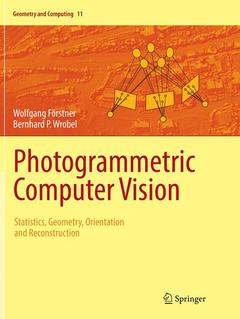Photogrammetric Computer Vision, Softcover reprint of the original 1st ed. 2016 Statistics, Geometry, Orientation and Reconstruction Geometry and Computing Series, Vol. 11
Auteurs : Förstner Wolfgang, Wrobel Bernhard P.

This textbook offers a statistical view on the geometry of multiple view analysis, required for camera calibration and orientation and for geometric scene reconstruction based on geometric image features. The authors have backgrounds in geodesy and also long experience with development and research in computer vision, and this is the first book to present a joint approach from the converging fields of photogrammetry and computer vision.
Part I of the book provides an introduction to estimation theory, covering aspects such as Bayesian estimation, variance components, and sequential estimation, with a focus on the statistically sound diagnostics of estimation results essential in vision metrology. Part II provides tools for 2D and 3D geometric reasoning using projective geometry. This includes oriented projective geometry and tools for statistically optimal estimation and test of geometric entities and transformations and their relations, tools that are useful also in the context of uncertain reasoning in point clouds. Part III is devoted to modelling the geometry of single and multiple cameras, addressing calibration and orientation, including statistical evaluation and reconstruction of corresponding scene features and surfaces based on geometric image features. The authors provide algorithms for various geometric computation problems in vision metrology, together with mathematical justifications and statistical analysis, thus enabling thorough evaluations. The chapters are self-contained with numerous figures and exercises, and they are supported by an appendix that explains the basic mathematical notation and a detailed index.
The book can serve as the basis for undergraduate and graduate courses in photogrammetry, computer vision, and computer graphics. It is also appropriate for researchers, engineers, and software developers in the photogrammetry and GIS industries, particularly those engaged with statistically based geometric computer vision methods.
Prof. Dr.-Ing. Wolfgang Förstner is an internationally leading expert in photogrammetry, computer vision, pattern recognition and machine learning. Throughout his exemplary career of nearly 40 years as a researcher, inventor, innovator and educator, he has made exceptionally significant scientific contributions in many areas of information from imagery and mentored generations of mapping scientists and engineers. Examples of his work include blunder detection for aerial triangulation, image matching, object recognition and statistical projective geometry. He developed the well-known Förstner Operator, for the detection of key points in images, in the 1980s. After studying geodesy and surveying, he first worked at the University of Stuttgart before moving to the University of Bonn as Professor for Photogrammetry where he led the Institute for Photogrammetry from 1990 to 2012. He published more than 100 academic papers, coauthored three book chapters for the ASPRS Manual of Photogrammetry, supervised more than 30 Ph.D. theses, and was closely involved with the International Society for Photogrammetry and Remote Sensing and the German Association for Pattern Recognition.
Prof. Dr.-Ing. Bernhard P. Wrobel received his Ph.D. (Dr.-Ing) in theoretical geodesy from the University of Bonn. From 1975 to 1981 he was professor for close-range photogrammetry and from 1981 to 2001 for photogrammetry at Darmstadt University of Technology, and also head of the Institute for Photogrammetry and Cartography. He was closely involved with the International Society for Photogrammetry and Remote Sensing, and he coauthored three book chapters for the ASPRS Manual of Photogrammetry. Besides his work related to precise mensuration tasks in industry, his research interests cover the mathematical fundamentals of photogrammetry such as the digital inversion of image formation for reconstruction of 3D surfaces and reflectance from multiple images.
Authors' we
Comprehensive explanation of mathematical fundamentals of photogrammetry
Emphasis on statistical view on geometric image analysis relevant for photogrammetry
Supported with exercises and appendix on mathematical basics
Includes supplementary material: sn.pub/extras
Date de parution : 06-2018
Ouvrage de 816 p.
21x27.9 cm
Disponible chez l'éditeur (délai d'approvisionnement : 15 jours).
Prix indicatif 63,29 €
Ajouter au panierDate de parution : 10-2016
Ouvrage de 816 p.
21x27.9 cm
Disponible chez l'éditeur (délai d'approvisionnement : 15 jours).
Prix indicatif 89,66 €
Ajouter au panier

